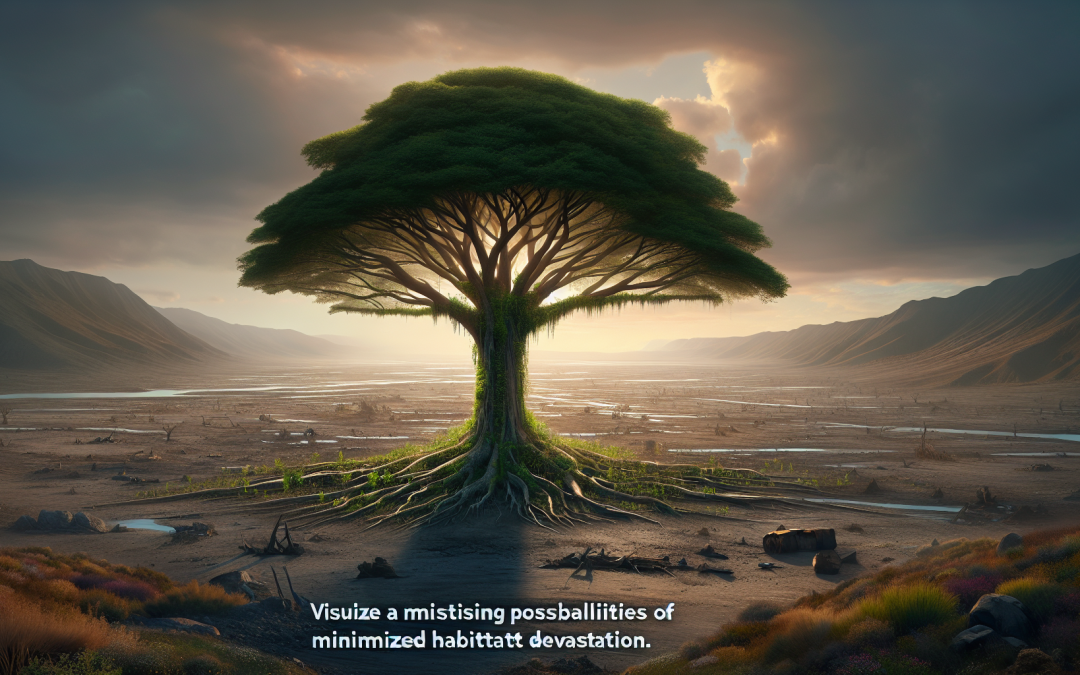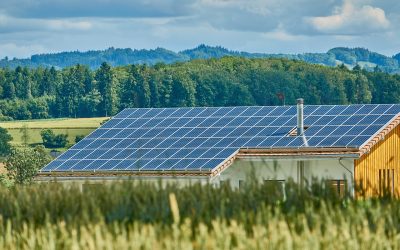You’ve probably heard about the alarming rates of habitat destruction across the globe, wiping out crucial ecosystems and endangering countless species. But what if I told you that there is hope on the horizon? In this article, we’ll explore the concept of reduced habitat destruction and the potential it holds for preserving our planet’s biodiversity. By shedding light on innovative conservation efforts and highlighting the benefits of sustainable practices, we’ll uncover how we can create a future where our natural resources are protected and vibrant habitats flourish. Buckle up, because the fight to save our environment just got a whole lot more promising.
Importance of Reducing Habitat Destruction
Preserving Biodiversity
Reducing habitat destruction is of utmost importance in order to preserve biodiversity. Habitats provide a home for a wide range of plant and animal species, and when these habitats are destroyed, it can lead to the loss of countless species. Biodiversity is crucial for maintaining a balanced and healthy ecosystem, as different species have unique roles in the food chain and contribute to important ecological processes. By minimizing habitat destruction, we can safeguard the rich tapestry of life on Earth and ensure that future generations can continue to benefit from the diverse array of species that inhabit our planet.
Mitigating Climate Change
One of the key benefits of reducing habitat destruction is the ability to mitigate climate change. Habitats such as forests play a vital role in absorbing carbon dioxide, a greenhouse gas that is a major contributor to global warming. Through the process of photosynthesis, trees and plants absorb carbon dioxide and release oxygen, helping to regulate the Earth’s climate. When habitats are destroyed, not only is carbon dioxide released back into the atmosphere, but the loss of trees and plants reduces the Earth’s capacity to absorb carbon dioxide. By reducing habitat destruction, we can help combat climate change and work towards a more sustainable future.
Protecting Ecosystem Services
Ecosystem services are the benefits that humans receive from the natural environment, including clean air and water, soil fertility, pollination, and climate regulation. These services are essential for our well-being and the functioning of our societies. However, when habitats are destroyed, ecosystem services are compromised. For example, deforestation can lead to soil erosion, water pollution, and the loss of natural pest control. By reducing habitat destruction, we can protect these vital ecosystem services and ensure a sustainable future for both humans and the environment.
Causes of Habitat Destruction
Deforestation
Deforestation, the clearing of forests for various purposes including agriculture, logging, and urbanization, is a major cause of habitat destruction. With the growing demand for timber, agricultural land, and urban spaces, vast areas of forests are being cleared at an alarming rate. This destruction of forest habitats not only leads to the loss of countless plant and animal species, but also contributes to climate change by releasing carbon dioxide into the atmosphere.
Urbanization
Urbanization, the expansion of cities and towns, is another significant cause of habitat destruction. As urban areas expand and infrastructure is developed, natural habitats are often cleared or fragmented. This process not only removes important habitats for wildlife, but also leads to the loss of green spaces, which are crucial for maintaining air quality, regulating temperatures, and providing recreational opportunities for urban dwellers.
Agricultural Expansion
Agricultural expansion, particularly for large-scale mono-crop farming, is a major driver of habitat destruction. As the global population continues to grow, there is an increasing demand for food production. This has led to the conversion of vast areas of natural habitats, such as forests and grasslands, into agricultural land. This conversion not only destroys habitats, but also leads to soil degradation, water pollution, and the loss of biodiversity.
Mining Activities
Mining activities, such as coal mining, oil extraction, and mineral mining, also contribute to habitat destruction. These activities often involve the clearing of large areas of land, the excavation of soil and rock, and the disposal of waste materials. This destruction of habitats can lead to the loss of biodiversity, the pollution of air and water, and the disruption of important ecological processes.
Infrastructure Development
The development of infrastructure, including roads, highways, dams, and power plants, is another significant cause of habitat destruction. These infrastructure projects often require the clearing of land and the alteration of natural habitats. This destruction can fragment habitats, isolate populations of plants and animals, and disrupt important ecological processes. It is crucial to carefully plan and consider the environmental impacts of infrastructure development in order to minimize habitat destruction.
Initiatives for Reducing Habitat Destruction
Enforcement of Environmental Laws
One of the key initiatives for reducing habitat destruction is the enforcement of environmental laws. Governments can play a crucial role in protecting habitats by implementing and enforcing regulations that restrict destructive activities. These laws can include restrictions on deforestation, urbanization, and mining activities, as well as the establishment of protected areas. By effectively enforcing these laws, governments can ensure that destructive activities are minimized and habitats are preserved.
Promotion of Sustainable Land Use
Promoting sustainable land use practices is another important initiative for reducing habitat destruction. This involves adopting agricultural practices that minimize habitat conversion and degradation, such as agroforestry and organic farming. It also includes promoting urban planning that incorporates green spaces and preserves natural habitats. By encouraging sustainable land use practices, we can ensure that habitats are protected while still meeting human needs for food, housing, and infrastructure.
Implementation of Protected Areas
The establishment and effective management of protected areas is a crucial initiative for reducing habitat destruction. Protected areas are designated areas of land or water that are set aside for the conservation of biodiversity and natural resources. These areas can range from national parks and wildlife sanctuaries to marine protected areas. By creating protected areas and enforcing regulations within them, we can ensure that important habitats and species are preserved for future generations.
Encouragement of Reforestation and Restoration
Reforestation and habitat restoration are important initiatives for reducing habitat destruction. Reforestation involves planting trees in areas where forests have been cleared, while habitat restoration involves restoring degraded habitats to their natural state. These initiatives not only help to reestablish important habitats for wildlife, but also contribute to carbon sequestration, soil conservation, and the improvement of local ecosystems.
Support for Indigenous Communities
Supporting and empowering indigenous communities is another important initiative for reducing habitat destruction. Indigenous peoples have lived in harmony with nature for generations and have valuable knowledge and practices that can contribute to habitat conservation. By recognizing indigenous land rights and supporting sustainable livelihoods for indigenous communities, we can promote the protection and preservation of habitats.
Collaboration between Stakeholders
Government Organizations
Government organizations play a crucial role in reducing habitat destruction through the implementation and enforcement of environmental regulations. They are responsible for developing policies, setting standards, and allocating resources for habitat conservation. Collaboration between different government departments, such as environmental agencies, forestry departments, and urban planning departments, is essential for effective habitat protection.
Non-Governmental Organizations (NGOs)
Non-governmental organizations, including environmental organizations and conservation groups, play a vital role in reducing habitat destruction. These organizations work on the ground to implement conservation projects, raise awareness, and advocate for policy changes. Through partnerships with other stakeholders, NGOs can have a significant impact on habitat conservation efforts.
Local Communities
Local communities are key stakeholders in reducing habitat destruction. They often depend on natural resources for their livelihoods and have a direct connection to the land. Engaging and involving local communities in conservation efforts can help ensure the success and sustainability of habitat protection initiatives. This can include providing training and support for sustainable livelihoods, establishing community-managed protected areas, and involving local communities in decision-making processes.
Private Sector
The private sector, including corporations and businesses, also plays a crucial role in reducing habitat destruction. By adopting sustainable practices and investing in conservation initiatives, companies can minimize their environmental footprint and contribute to habitat protection. Collaboration between the private sector and other stakeholders, such as governments and NGOs, is essential for achieving sustainable outcomes.
International Cooperation
International cooperation is crucial for addressing habitat destruction, as habitats and species often transcend national boundaries. Collaboration between countries, through initiatives such as international agreements, can help ensure the coordinated and effective protection of habitats. This can include sharing knowledge and best practices, coordinating conservation efforts, and providing financial and technical support to less-developed countries.
Awareness and Education
Educating Communities
Educating communities about the importance of habitat conservation is a key factor in reducing habitat destruction. By raising awareness about the value of habitats and the threats they face, individuals can be empowered to make environmentally conscious choices. This can include educating communities about sustainable land use practices, the benefits of biodiversity, and the impacts of habitat destruction on their own well-being.
Raising Awareness through Media
The media plays a crucial role in raising awareness about habitat destruction. By highlighting the importance of habitats and the threats they face, media outlets can help educate the public and mobilize support for conservation efforts. This can include news articles, documentaries, social media campaigns, and other forms of media that reach a wide audience.
Incorporating Environmental Education into School Curriculum
Incorporating environmental education into the school curriculum is an effective way to instill a sense of environmental responsibility in future generations. By teaching students about the importance of habitats, biodiversity, and sustainable practices, we can foster a generation of environmentally conscious individuals who will help protect habitats in the future. This can include outdoor field trips, hands-on activities, and incorporating environmental themes into various subjects.
Promoting Sustainable Tourism
Promoting sustainable tourism is another important aspect of raising awareness about habitat destruction. By educating tourists about the importance of habitats and encouraging responsible travel practices, we can minimize the negative impacts of tourism on natural ecosystems. This can include promoting eco-friendly accommodations, providing information about local conservation efforts, and encouraging tourists to support local communities and conservation initiatives.
Incentives for Landowners and Companies
Financial Support
Providing financial support to landowners and companies who actively engage in habitat conservation can be a powerful incentive for reducing habitat destruction. This can include grants, subsidies, and other financial incentives that encourage sustainable land use practices and the protection of habitats. By providing financial support, governments and other stakeholders can help offset the costs of conservation efforts and make sustainable practices more economically viable.
Tax Breaks and Incentive Programs
Tax breaks and incentive programs can also serve as effective incentives for landowners and companies to engage in habitat conservation. By reducing taxes or providing other financial incentives to those who actively protect habitats, governments can encourage responsible land use and conservation practices. This can create a win-win situation where landowners and companies are rewarded for their efforts in contributing to habitat protection.
Certification Schemes
Certification schemes, such as sustainable forestry certifications and eco-labeling programs, can incentivize responsible land use and habitat conservation. These schemes provide recognition and market advantages to landowners and companies who demonstrate sustainable practices. By adhering to certification standards, landowners and companies can access new markets, gain consumer trust, and differentiate themselves from competitors.
Partnerships with Conservation Organizations
Establishing partnerships with conservation organizations can provide landowners and companies with expertise, resources, and support for habitat conservation efforts. By collaborating with conservation organizations, landowners and companies can access knowledge and best practices, receive technical assistance, and benefit from the credibility and reputation of these organizations. Partnerships can also facilitate the sharing of resources and the implementation of joint conservation projects.
Monitoring and Assessment
Satellite Imagery and Remote Sensing
Satellite imagery and remote sensing technologies play a crucial role in monitoring and assessing habitat destruction. These technologies provide valuable information about changes in land cover, vegetation health, and habitat connectivity over time. By analyzing satellite images and remote sensing data, scientists and policymakers can identify areas of high habitat destruction, track the progress of conservation efforts, and evaluate the effectiveness of conservation strategies.
Field Surveys and Data Collection
Field surveys and data collection are essential for monitoring and assessing habitat destruction on the ground. By conducting field surveys, scientists can gather data on the presence and abundance of species, the condition of habitats, and the impacts of human activities. This data is crucial for understanding the status of habitats, identifying threats, and designing effective conservation strategies.
Integrated Monitoring Systems
Integrated monitoring systems that combine satellite imagery, remote sensing data, and field surveys are ideal for tracking habitat destruction and evaluating conservation efforts. These systems allow for a comprehensive and holistic understanding of habitat changes, enabling scientists and policymakers to make informed decisions. By integrating different data sources and monitoring techniques, stakeholders can monitor habitats and identify trends, enabling timely intervention and adaptive management.
Assessment of Conservation Strategies
Assessing the effectiveness of conservation strategies is important for refining and improving habitat protection efforts. By evaluating the outcomes and impacts of conservation projects, stakeholders can identify what works and what needs to be adjusted. This can involve conducting scientific studies, monitoring key indicators, and engaging with local communities to gather feedback. Regular assessment helps ensure that conservation strategies are evidence-based, efficient, and aligned with the goals of habitat protection.
Addressing Policy and Governance
Strengthening Environmental Regulations
Addressing policy and governance is crucial for reducing habitat destruction. Governments can strengthen environmental regulations by enacting stricter legislation, increasing penalties for illegal activities, and improving enforcement mechanisms. By creating a legal framework that prioritizes habitat protection, governments can send a strong message that destructive activities will not be tolerated.
Integrating Conservation into Land Use Planning
Integrating habitat conservation into land use planning processes is essential for preventing habitat destruction. Governments can incorporate conservation goals and requirements into land use plans and zoning regulations. This can include designating protected areas, establishing buffer zones around sensitive habitats, and setting limits on extractive industries. By integrating conservation into land use planning, governments can ensure that habitats are considered in development decisions and that sustainable practices are encouraged.
Promoting Sustainable Resource Management
Promoting sustainable resource management is another important aspect of addressing habitat destruction. Governments can implement policies and practices that ensure the sustainable use of natural resources, such as timber, minerals, and water. This can include promoting sustainable forestry practices, implementing responsible mining regulations, and establishing water management plans. By managing resources in a sustainable way, governments can minimize the negative impacts on habitats and ensure their long-term viability.
Enhancing International Cooperation on Habitat Protection
Addressing habitat destruction requires enhanced international cooperation and collaboration. Governments can work together through international agreements, conventions, and treaties to strengthen habitat protection efforts. This can involve sharing knowledge and best practices, coordinating conservation initiatives, and providing financial and technical support to countries in need. By collaborating at a global level, governments can make significant strides in reducing habitat destruction and protecting the world’s most vulnerable habitats and species.
Impact of Reduced Habitat Destruction
Preservation of Endangered Species
Reducing habitat destruction can have a significant impact on the preservation of endangered species. Many endangered species rely on specific habitats for their survival, and when these habitats are destroyed, their populations decline rapidly. By protecting and preserving habitats, we can provide a safe haven for endangered species, allowing them to recover and thrive. This is crucial for maintaining the ecological balance and biodiversity of our planet.
Improved Air and Water Quality
Reduced habitat destruction can lead to improved air and water quality. Healthy habitats, such as forests and wetlands, act as natural filters, removing pollutants and purifying the air and water. When habitats are destroyed, these natural filtration systems are compromised, leading to degraded air and water quality. By preserving habitats, we can ensure that the air we breathe and the water we drink remain clean and safe for both humans and wildlife.
Sustainable Livelihoods
Reducing habitat destruction can also contribute to sustainable livelihoods for communities that depend on natural resources. Many communities rely on habitats for their food, income, and cultural practices. By protecting habitats and promoting sustainable resource management, we can ensure the long-term viability of these livelihoods. This can include supporting sustainable agriculture, promoting eco-tourism, and providing alternative income opportunities that are compatible with habitat conservation.
Enhanced Resilience to Climate Change
Preserving habitats is crucial for enhancing the resilience of ecosystems to climate change. Healthy habitats are better able to withstand the impacts of climate change, such as extreme weather events and shifting temperature patterns. They provide a buffer against climate-related risks, protect against flooding, and support the adaptation of species to changing conditions. By reducing habitat destruction, we can promote ecosystem resilience and enhance the capacity of ecosystems to cope with climate change impacts.
Challenges and Future Perspectives
Balancing Economic Development with Conservation
One of the key challenges in reducing habitat destruction is balancing economic development with conservation. As populations grow and economies expand, there is increased pressure on natural resources and habitats. Finding the right balance between development and conservation is crucial for ensuring sustainable and equitable outcomes. This requires integrating conservation goals into development planning, promoting sustainable practices, and engaging stakeholders in decision-making processes.
Addressing Corruption and Illegal Activities
Corruption and illegal activities pose significant challenges to reducing habitat destruction. Weak governance, lack of law enforcement, and corruption can undermine conservation efforts and perpetuate destructive activities. Addressing corruption and combatting illegal activities, such as illegal logging and wildlife trafficking, is crucial for effective habitat protection. This requires strengthening law enforcement, promoting transparency and accountability, and empowering local communities to report and combat illegal activities.
Engaging Local Communities for Long-term Success
Engaging local communities is essential for the long-term success of habitat protection initiatives. Local communities often have valuable knowledge, practices, and a vested interest in preserving habitats. Empowering local communities, recognizing their rights, and involving them in decision-making processes are key strategies for ensuring the sustainability and effectiveness of conservation efforts. This can include providing training and support for sustainable livelihoods, establishing community-managed protected areas, and promoting environmental education.
Promoting Research and Innovation
Promoting research and innovation is crucial for advancing habitat protection efforts. Scientific research can provide valuable insights into the impacts of habitat destruction, the effectiveness of conservation strategies, and the resilience of ecosystems. By investing in research and innovation, stakeholders can develop and implement evidence-based conservation strategies, identify emerging threats, and adapt to changing circumstances. This can include supporting research institutions, fostering collaborations between researchers and practitioners, and promoting the use of cutting-edge technologies and methodologies.
Continued Advocacy for Habitat Protection
Advocacy for habitat protection is an ongoing and essential effort. Continued advocacy is needed to raise awareness about the importance of habitats, mobilize support for conservation initiatives, and hold governments and other stakeholders accountable. This can involve advocating for stronger environmental regulations, promoting sustainable practices, and engaging the public through campaigns, petitions, and grassroots movements. By staying vigilant and persistent in our advocacy, we can ensure that habitat protection remains a priority on the global agenda.










